Analysis of Leadership Capabilities
VerifiedAdded on 2023/06/10
|17
|4438
|250
AI Summary
This article discusses the different theories, skills, and styles of leadership and how they can be developed to become a successful leader. It also explains the difference between leadership and management.
Contribute Materials
Your contribution can guide someone’s learning journey. Share your
documents today.
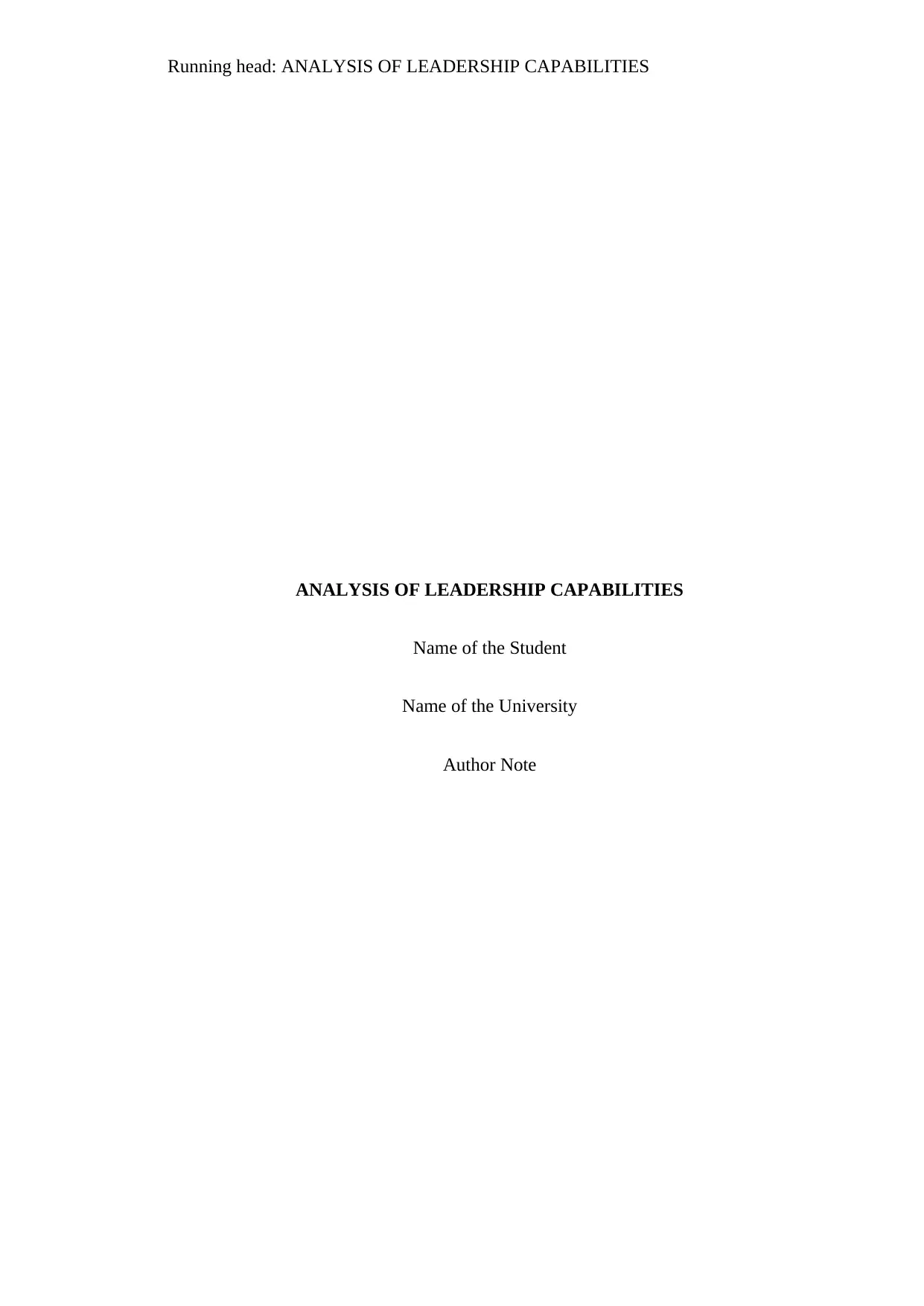
Running head: ANALYSIS OF LEADERSHIP CAPABILITIES
ANALYSIS OF LEADERSHIP CAPABILITIES
Name of the Student
Name of the University
Author Note
ANALYSIS OF LEADERSHIP CAPABILITIES
Name of the Student
Name of the University
Author Note
Secure Best Marks with AI Grader
Need help grading? Try our AI Grader for instant feedback on your assignments.
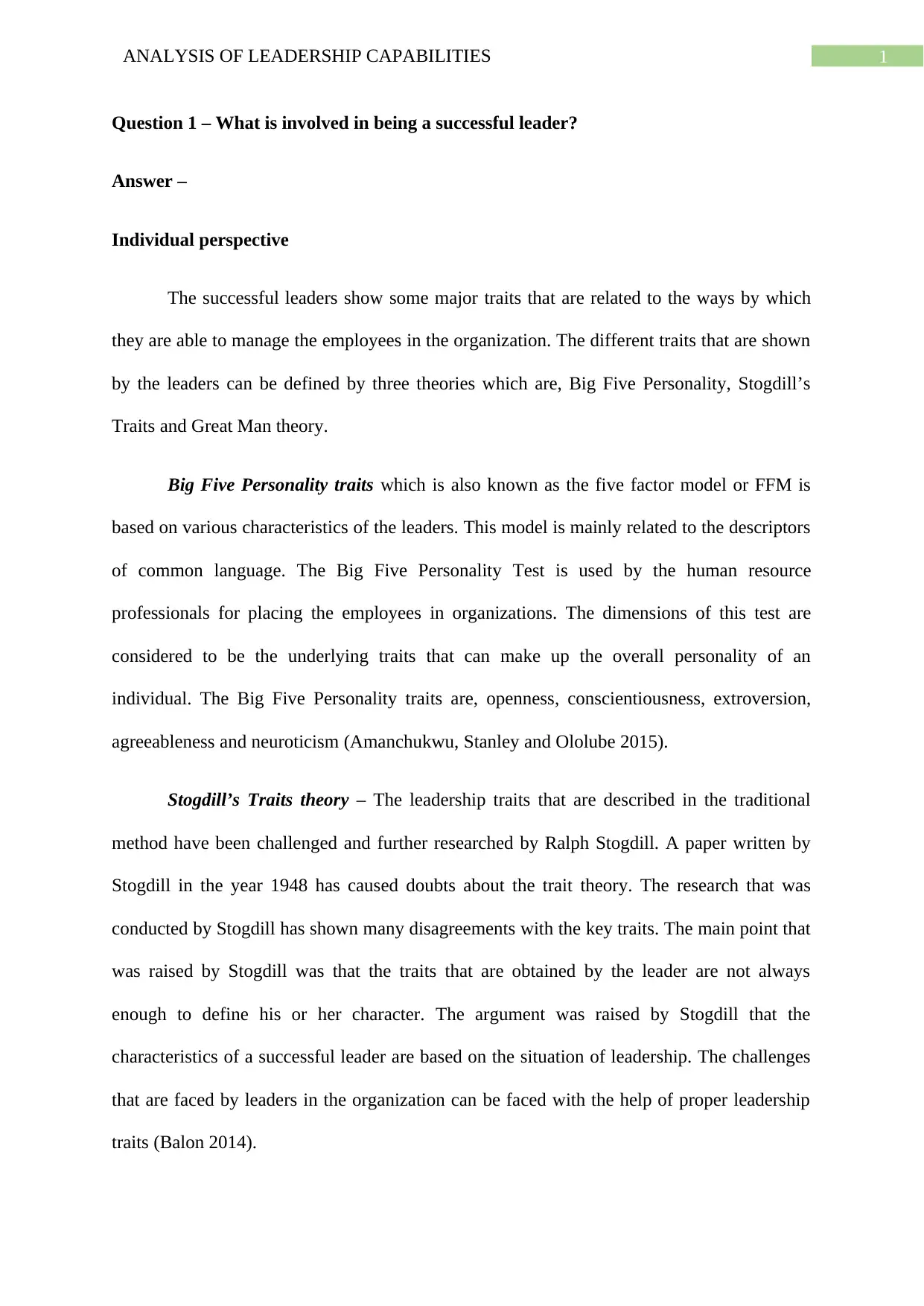
1ANALYSIS OF LEADERSHIP CAPABILITIES
Question 1 – What is involved in being a successful leader?
Answer –
Individual perspective
The successful leaders show some major traits that are related to the ways by which
they are able to manage the employees in the organization. The different traits that are shown
by the leaders can be defined by three theories which are, Big Five Personality, Stogdill’s
Traits and Great Man theory.
Big Five Personality traits which is also known as the five factor model or FFM is
based on various characteristics of the leaders. This model is mainly related to the descriptors
of common language. The Big Five Personality Test is used by the human resource
professionals for placing the employees in organizations. The dimensions of this test are
considered to be the underlying traits that can make up the overall personality of an
individual. The Big Five Personality traits are, openness, conscientiousness, extroversion,
agreeableness and neuroticism (Amanchukwu, Stanley and Ololube 2015).
Stogdill’s Traits theory – The leadership traits that are described in the traditional
method have been challenged and further researched by Ralph Stogdill. A paper written by
Stogdill in the year 1948 has caused doubts about the trait theory. The research that was
conducted by Stogdill has shown many disagreements with the key traits. The main point that
was raised by Stogdill was that the traits that are obtained by the leader are not always
enough to define his or her character. The argument was raised by Stogdill that the
characteristics of a successful leader are based on the situation of leadership. The challenges
that are faced by leaders in the organization can be faced with the help of proper leadership
traits (Balon 2014).
Question 1 – What is involved in being a successful leader?
Answer –
Individual perspective
The successful leaders show some major traits that are related to the ways by which
they are able to manage the employees in the organization. The different traits that are shown
by the leaders can be defined by three theories which are, Big Five Personality, Stogdill’s
Traits and Great Man theory.
Big Five Personality traits which is also known as the five factor model or FFM is
based on various characteristics of the leaders. This model is mainly related to the descriptors
of common language. The Big Five Personality Test is used by the human resource
professionals for placing the employees in organizations. The dimensions of this test are
considered to be the underlying traits that can make up the overall personality of an
individual. The Big Five Personality traits are, openness, conscientiousness, extroversion,
agreeableness and neuroticism (Amanchukwu, Stanley and Ololube 2015).
Stogdill’s Traits theory – The leadership traits that are described in the traditional
method have been challenged and further researched by Ralph Stogdill. A paper written by
Stogdill in the year 1948 has caused doubts about the trait theory. The research that was
conducted by Stogdill has shown many disagreements with the key traits. The main point that
was raised by Stogdill was that the traits that are obtained by the leader are not always
enough to define his or her character. The argument was raised by Stogdill that the
characteristics of a successful leader are based on the situation of leadership. The challenges
that are faced by leaders in the organization can be faced with the help of proper leadership
traits (Balon 2014).
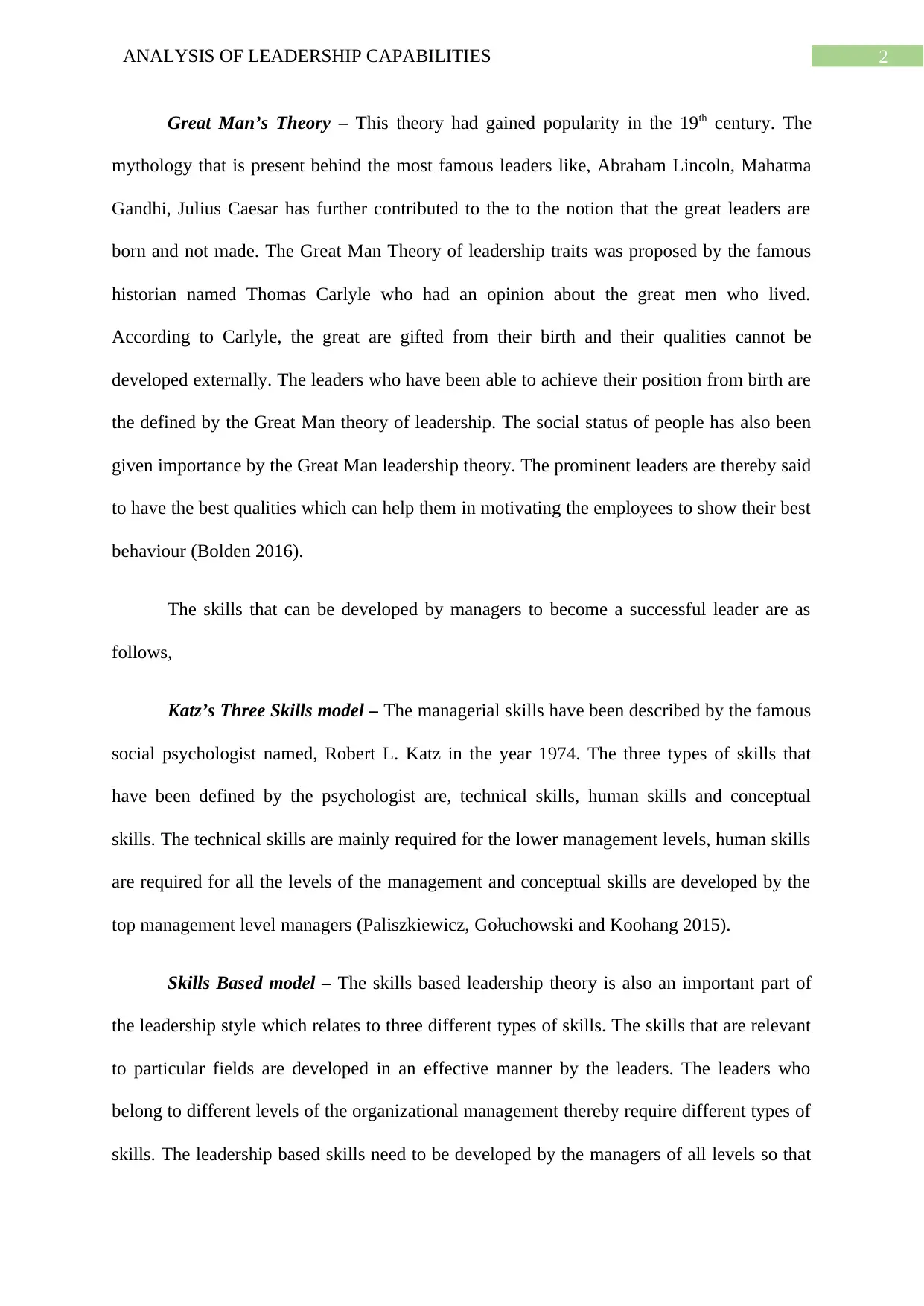
2ANALYSIS OF LEADERSHIP CAPABILITIES
Great Man’s Theory – This theory had gained popularity in the 19th century. The
mythology that is present behind the most famous leaders like, Abraham Lincoln, Mahatma
Gandhi, Julius Caesar has further contributed to the to the notion that the great leaders are
born and not made. The Great Man Theory of leadership traits was proposed by the famous
historian named Thomas Carlyle who had an opinion about the great men who lived.
According to Carlyle, the great are gifted from their birth and their qualities cannot be
developed externally. The leaders who have been able to achieve their position from birth are
the defined by the Great Man theory of leadership. The social status of people has also been
given importance by the Great Man leadership theory. The prominent leaders are thereby said
to have the best qualities which can help them in motivating the employees to show their best
behaviour (Bolden 2016).
The skills that can be developed by managers to become a successful leader are as
follows,
Katz’s Three Skills model – The managerial skills have been described by the famous
social psychologist named, Robert L. Katz in the year 1974. The three types of skills that
have been defined by the psychologist are, technical skills, human skills and conceptual
skills. The technical skills are mainly required for the lower management levels, human skills
are required for all the levels of the management and conceptual skills are developed by the
top management level managers (Paliszkiewicz, Gołuchowski and Koohang 2015).
Skills Based model – The skills based leadership theory is also an important part of
the leadership style which relates to three different types of skills. The skills that are relevant
to particular fields are developed in an effective manner by the leaders. The leaders who
belong to different levels of the organizational management thereby require different types of
skills. The leadership based skills need to be developed by the managers of all levels so that
Great Man’s Theory – This theory had gained popularity in the 19th century. The
mythology that is present behind the most famous leaders like, Abraham Lincoln, Mahatma
Gandhi, Julius Caesar has further contributed to the to the notion that the great leaders are
born and not made. The Great Man Theory of leadership traits was proposed by the famous
historian named Thomas Carlyle who had an opinion about the great men who lived.
According to Carlyle, the great are gifted from their birth and their qualities cannot be
developed externally. The leaders who have been able to achieve their position from birth are
the defined by the Great Man theory of leadership. The social status of people has also been
given importance by the Great Man leadership theory. The prominent leaders are thereby said
to have the best qualities which can help them in motivating the employees to show their best
behaviour (Bolden 2016).
The skills that can be developed by managers to become a successful leader are as
follows,
Katz’s Three Skills model – The managerial skills have been described by the famous
social psychologist named, Robert L. Katz in the year 1974. The three types of skills that
have been defined by the psychologist are, technical skills, human skills and conceptual
skills. The technical skills are mainly required for the lower management levels, human skills
are required for all the levels of the management and conceptual skills are developed by the
top management level managers (Paliszkiewicz, Gołuchowski and Koohang 2015).
Skills Based model – The skills based leadership theory is also an important part of
the leadership style which relates to three different types of skills. The skills that are relevant
to particular fields are developed in an effective manner by the leaders. The leaders who
belong to different levels of the organizational management thereby require different types of
skills. The leadership based skills need to be developed by the managers of all levels so that
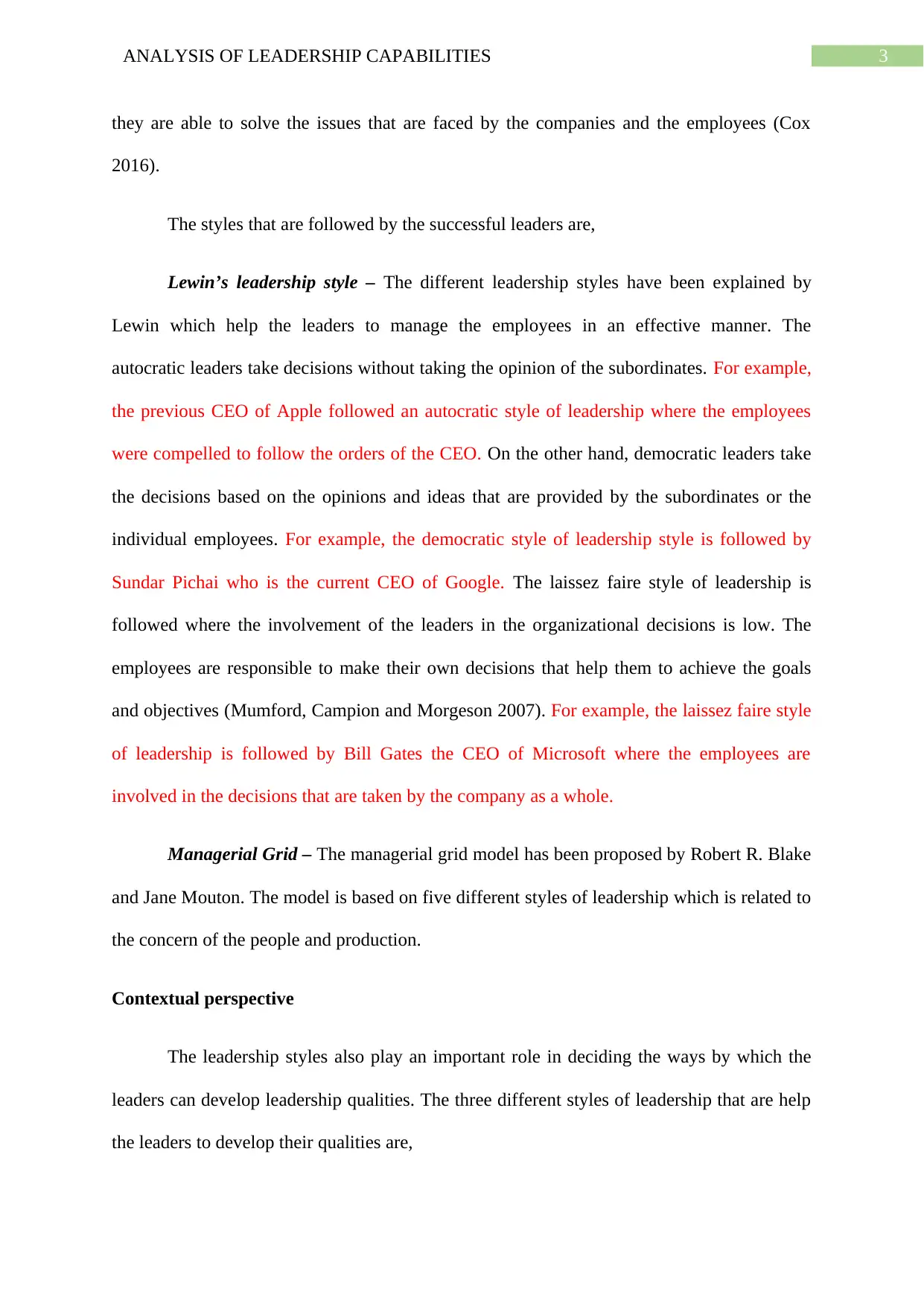
3ANALYSIS OF LEADERSHIP CAPABILITIES
they are able to solve the issues that are faced by the companies and the employees (Cox
2016).
The styles that are followed by the successful leaders are,
Lewin’s leadership style – The different leadership styles have been explained by
Lewin which help the leaders to manage the employees in an effective manner. The
autocratic leaders take decisions without taking the opinion of the subordinates. For example,
the previous CEO of Apple followed an autocratic style of leadership where the employees
were compelled to follow the orders of the CEO. On the other hand, democratic leaders take
the decisions based on the opinions and ideas that are provided by the subordinates or the
individual employees. For example, the democratic style of leadership style is followed by
Sundar Pichai who is the current CEO of Google. The laissez faire style of leadership is
followed where the involvement of the leaders in the organizational decisions is low. The
employees are responsible to make their own decisions that help them to achieve the goals
and objectives (Mumford, Campion and Morgeson 2007). For example, the laissez faire style
of leadership is followed by Bill Gates the CEO of Microsoft where the employees are
involved in the decisions that are taken by the company as a whole.
Managerial Grid – The managerial grid model has been proposed by Robert R. Blake
and Jane Mouton. The model is based on five different styles of leadership which is related to
the concern of the people and production.
Contextual perspective
The leadership styles also play an important role in deciding the ways by which the
leaders can develop leadership qualities. The three different styles of leadership that are help
the leaders to develop their qualities are,
they are able to solve the issues that are faced by the companies and the employees (Cox
2016).
The styles that are followed by the successful leaders are,
Lewin’s leadership style – The different leadership styles have been explained by
Lewin which help the leaders to manage the employees in an effective manner. The
autocratic leaders take decisions without taking the opinion of the subordinates. For example,
the previous CEO of Apple followed an autocratic style of leadership where the employees
were compelled to follow the orders of the CEO. On the other hand, democratic leaders take
the decisions based on the opinions and ideas that are provided by the subordinates or the
individual employees. For example, the democratic style of leadership style is followed by
Sundar Pichai who is the current CEO of Google. The laissez faire style of leadership is
followed where the involvement of the leaders in the organizational decisions is low. The
employees are responsible to make their own decisions that help them to achieve the goals
and objectives (Mumford, Campion and Morgeson 2007). For example, the laissez faire style
of leadership is followed by Bill Gates the CEO of Microsoft where the employees are
involved in the decisions that are taken by the company as a whole.
Managerial Grid – The managerial grid model has been proposed by Robert R. Blake
and Jane Mouton. The model is based on five different styles of leadership which is related to
the concern of the people and production.
Contextual perspective
The leadership styles also play an important role in deciding the ways by which the
leaders can develop leadership qualities. The three different styles of leadership that are help
the leaders to develop their qualities are,
Paraphrase This Document
Need a fresh take? Get an instant paraphrase of this document with our AI Paraphraser
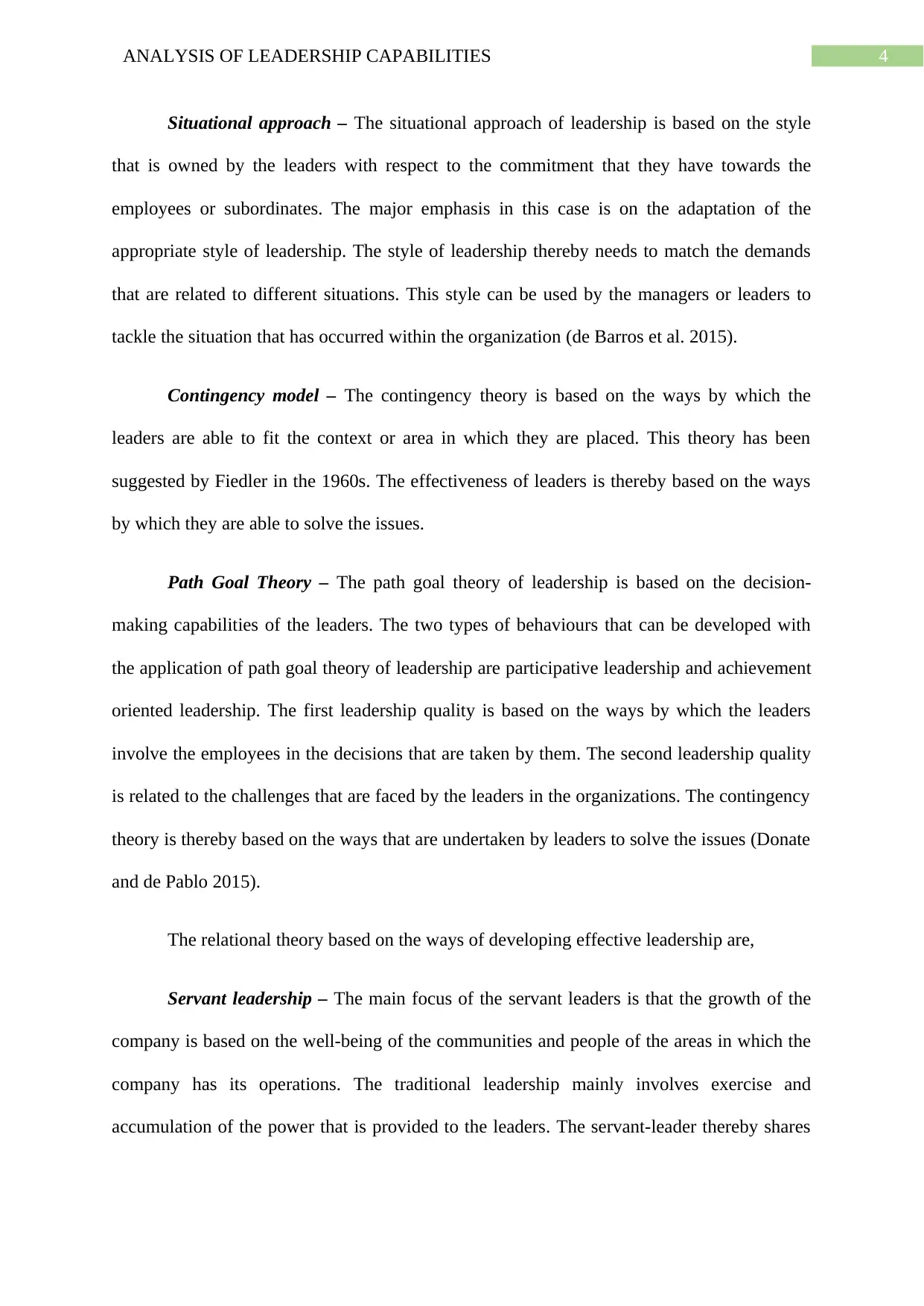
4ANALYSIS OF LEADERSHIP CAPABILITIES
Situational approach – The situational approach of leadership is based on the style
that is owned by the leaders with respect to the commitment that they have towards the
employees or subordinates. The major emphasis in this case is on the adaptation of the
appropriate style of leadership. The style of leadership thereby needs to match the demands
that are related to different situations. This style can be used by the managers or leaders to
tackle the situation that has occurred within the organization (de Barros et al. 2015).
Contingency model – The contingency theory is based on the ways by which the
leaders are able to fit the context or area in which they are placed. This theory has been
suggested by Fiedler in the 1960s. The effectiveness of leaders is thereby based on the ways
by which they are able to solve the issues.
Path Goal Theory – The path goal theory of leadership is based on the decision-
making capabilities of the leaders. The two types of behaviours that can be developed with
the application of path goal theory of leadership are participative leadership and achievement
oriented leadership. The first leadership quality is based on the ways by which the leaders
involve the employees in the decisions that are taken by them. The second leadership quality
is related to the challenges that are faced by the leaders in the organizations. The contingency
theory is thereby based on the ways that are undertaken by leaders to solve the issues (Donate
and de Pablo 2015).
The relational theory based on the ways of developing effective leadership are,
Servant leadership – The main focus of the servant leaders is that the growth of the
company is based on the well-being of the communities and people of the areas in which the
company has its operations. The traditional leadership mainly involves exercise and
accumulation of the power that is provided to the leaders. The servant-leader thereby shares
Situational approach – The situational approach of leadership is based on the style
that is owned by the leaders with respect to the commitment that they have towards the
employees or subordinates. The major emphasis in this case is on the adaptation of the
appropriate style of leadership. The style of leadership thereby needs to match the demands
that are related to different situations. This style can be used by the managers or leaders to
tackle the situation that has occurred within the organization (de Barros et al. 2015).
Contingency model – The contingency theory is based on the ways by which the
leaders are able to fit the context or area in which they are placed. This theory has been
suggested by Fiedler in the 1960s. The effectiveness of leaders is thereby based on the ways
by which they are able to solve the issues.
Path Goal Theory – The path goal theory of leadership is based on the decision-
making capabilities of the leaders. The two types of behaviours that can be developed with
the application of path goal theory of leadership are participative leadership and achievement
oriented leadership. The first leadership quality is based on the ways by which the leaders
involve the employees in the decisions that are taken by them. The second leadership quality
is related to the challenges that are faced by the leaders in the organizations. The contingency
theory is thereby based on the ways that are undertaken by leaders to solve the issues (Donate
and de Pablo 2015).
The relational theory based on the ways of developing effective leadership are,
Servant leadership – The main focus of the servant leaders is that the growth of the
company is based on the well-being of the communities and people of the areas in which the
company has its operations. The traditional leadership mainly involves exercise and
accumulation of the power that is provided to the leaders. The servant-leader thereby shares

5ANALYSIS OF LEADERSHIP CAPABILITIES
the power and places the needs of people first as compared to the other issues (Edwards et al.
2015).
Transformational leadership – The transformational leadership is a process which
helps in the transformation of the individuals. The influence of the transformational leaders is
able to move the followers and the organizational processes as well. This is mainly based on
the values, emotions, standards and ethics of managers and the employees. The
transformational leaders are attentive towards the needs and desires of the employees (Gold
and Thorpe 2016).
Leader Member exchange theory - The leader-member exchange theory is based on
the situational leadership model. This mainly refers to the loyalty, attraction and confidence
of the followers regarding their followers. Good relationships are based on high degrees of
subordinate trust and bad relationships refer to little trust of the subordinates on their leaders.
This theory helps in the development of proper leadership qualities of the managers. The
leaders can thereby develop the skills that are required to solve various issues that are faced
by the employees. The leadership styles on the other hand can also be developed in an
effective manner which can help the leaders in managing the employees (Mumford et al.
2000). The different leadership styles affect the ways that are used by the leaders in order to
manage the employees. The transformational leaders work along with the employees to
achieve the objectives and the servant leaders work for the profit of the individuals who
belong to the area in which they operate (Kotter 1990).
Question 2-Can good leadership be developed, and if so, how?
Answer –
Individual perspective
the power and places the needs of people first as compared to the other issues (Edwards et al.
2015).
Transformational leadership – The transformational leadership is a process which
helps in the transformation of the individuals. The influence of the transformational leaders is
able to move the followers and the organizational processes as well. This is mainly based on
the values, emotions, standards and ethics of managers and the employees. The
transformational leaders are attentive towards the needs and desires of the employees (Gold
and Thorpe 2016).
Leader Member exchange theory - The leader-member exchange theory is based on
the situational leadership model. This mainly refers to the loyalty, attraction and confidence
of the followers regarding their followers. Good relationships are based on high degrees of
subordinate trust and bad relationships refer to little trust of the subordinates on their leaders.
This theory helps in the development of proper leadership qualities of the managers. The
leaders can thereby develop the skills that are required to solve various issues that are faced
by the employees. The leadership styles on the other hand can also be developed in an
effective manner which can help the leaders in managing the employees (Mumford et al.
2000). The different leadership styles affect the ways that are used by the leaders in order to
manage the employees. The transformational leaders work along with the employees to
achieve the objectives and the servant leaders work for the profit of the individuals who
belong to the area in which they operate (Kotter 1990).
Question 2-Can good leadership be developed, and if so, how?
Answer –
Individual perspective
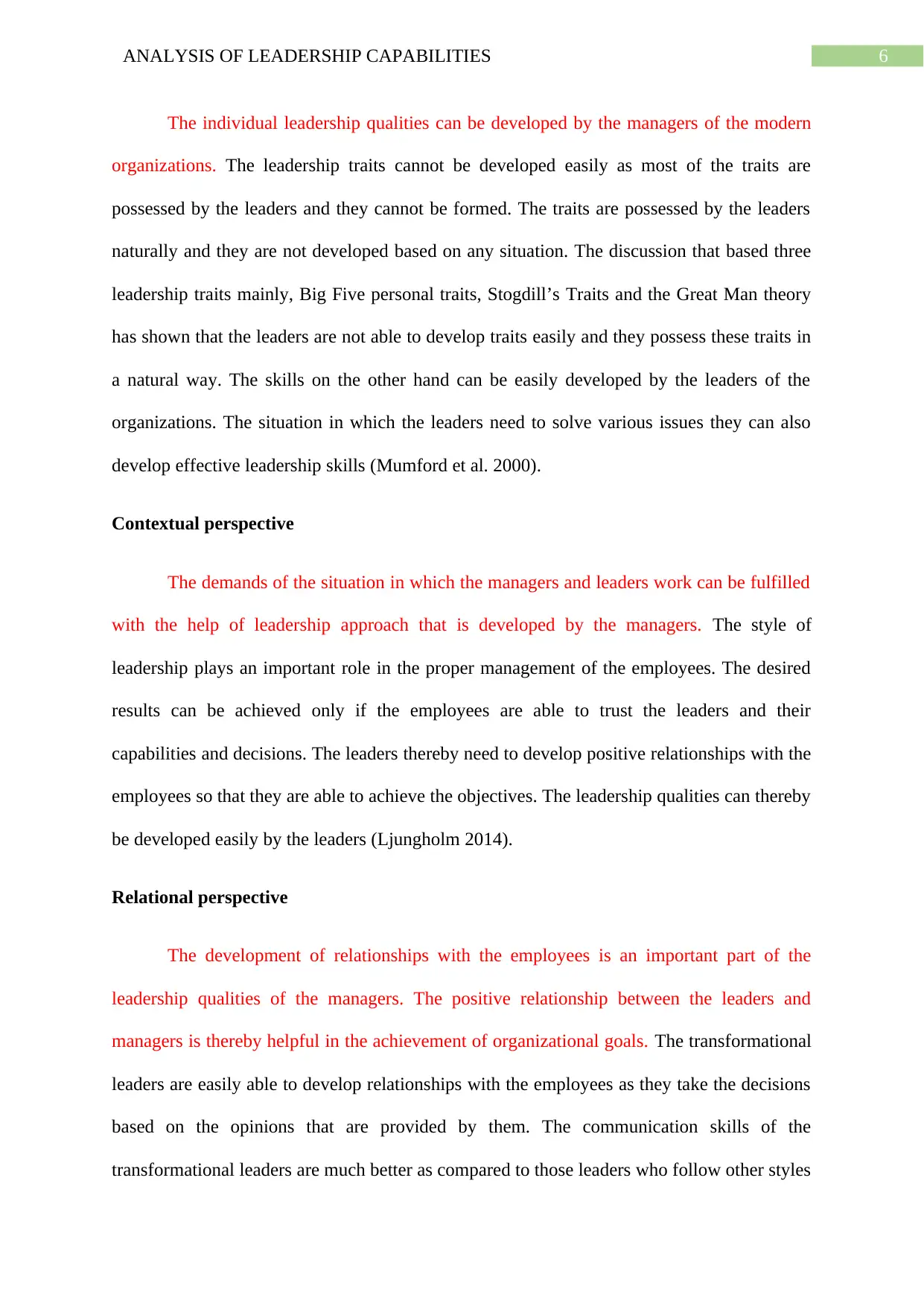
6ANALYSIS OF LEADERSHIP CAPABILITIES
The individual leadership qualities can be developed by the managers of the modern
organizations. The leadership traits cannot be developed easily as most of the traits are
possessed by the leaders and they cannot be formed. The traits are possessed by the leaders
naturally and they are not developed based on any situation. The discussion that based three
leadership traits mainly, Big Five personal traits, Stogdill’s Traits and the Great Man theory
has shown that the leaders are not able to develop traits easily and they possess these traits in
a natural way. The skills on the other hand can be easily developed by the leaders of the
organizations. The situation in which the leaders need to solve various issues they can also
develop effective leadership skills (Mumford et al. 2000).
Contextual perspective
The demands of the situation in which the managers and leaders work can be fulfilled
with the help of leadership approach that is developed by the managers. The style of
leadership plays an important role in the proper management of the employees. The desired
results can be achieved only if the employees are able to trust the leaders and their
capabilities and decisions. The leaders thereby need to develop positive relationships with the
employees so that they are able to achieve the objectives. The leadership qualities can thereby
be developed easily by the leaders (Ljungholm 2014).
Relational perspective
The development of relationships with the employees is an important part of the
leadership qualities of the managers. The positive relationship between the leaders and
managers is thereby helpful in the achievement of organizational goals. The transformational
leaders are easily able to develop relationships with the employees as they take the decisions
based on the opinions that are provided by them. The communication skills of the
transformational leaders are much better as compared to those leaders who follow other styles
The individual leadership qualities can be developed by the managers of the modern
organizations. The leadership traits cannot be developed easily as most of the traits are
possessed by the leaders and they cannot be formed. The traits are possessed by the leaders
naturally and they are not developed based on any situation. The discussion that based three
leadership traits mainly, Big Five personal traits, Stogdill’s Traits and the Great Man theory
has shown that the leaders are not able to develop traits easily and they possess these traits in
a natural way. The skills on the other hand can be easily developed by the leaders of the
organizations. The situation in which the leaders need to solve various issues they can also
develop effective leadership skills (Mumford et al. 2000).
Contextual perspective
The demands of the situation in which the managers and leaders work can be fulfilled
with the help of leadership approach that is developed by the managers. The style of
leadership plays an important role in the proper management of the employees. The desired
results can be achieved only if the employees are able to trust the leaders and their
capabilities and decisions. The leaders thereby need to develop positive relationships with the
employees so that they are able to achieve the objectives. The leadership qualities can thereby
be developed easily by the leaders (Ljungholm 2014).
Relational perspective
The development of relationships with the employees is an important part of the
leadership qualities of the managers. The positive relationship between the leaders and
managers is thereby helpful in the achievement of organizational goals. The transformational
leaders are easily able to develop relationships with the employees as they take the decisions
based on the opinions that are provided by them. The communication skills of the
transformational leaders are much better as compared to those leaders who follow other styles
Secure Best Marks with AI Grader
Need help grading? Try our AI Grader for instant feedback on your assignments.
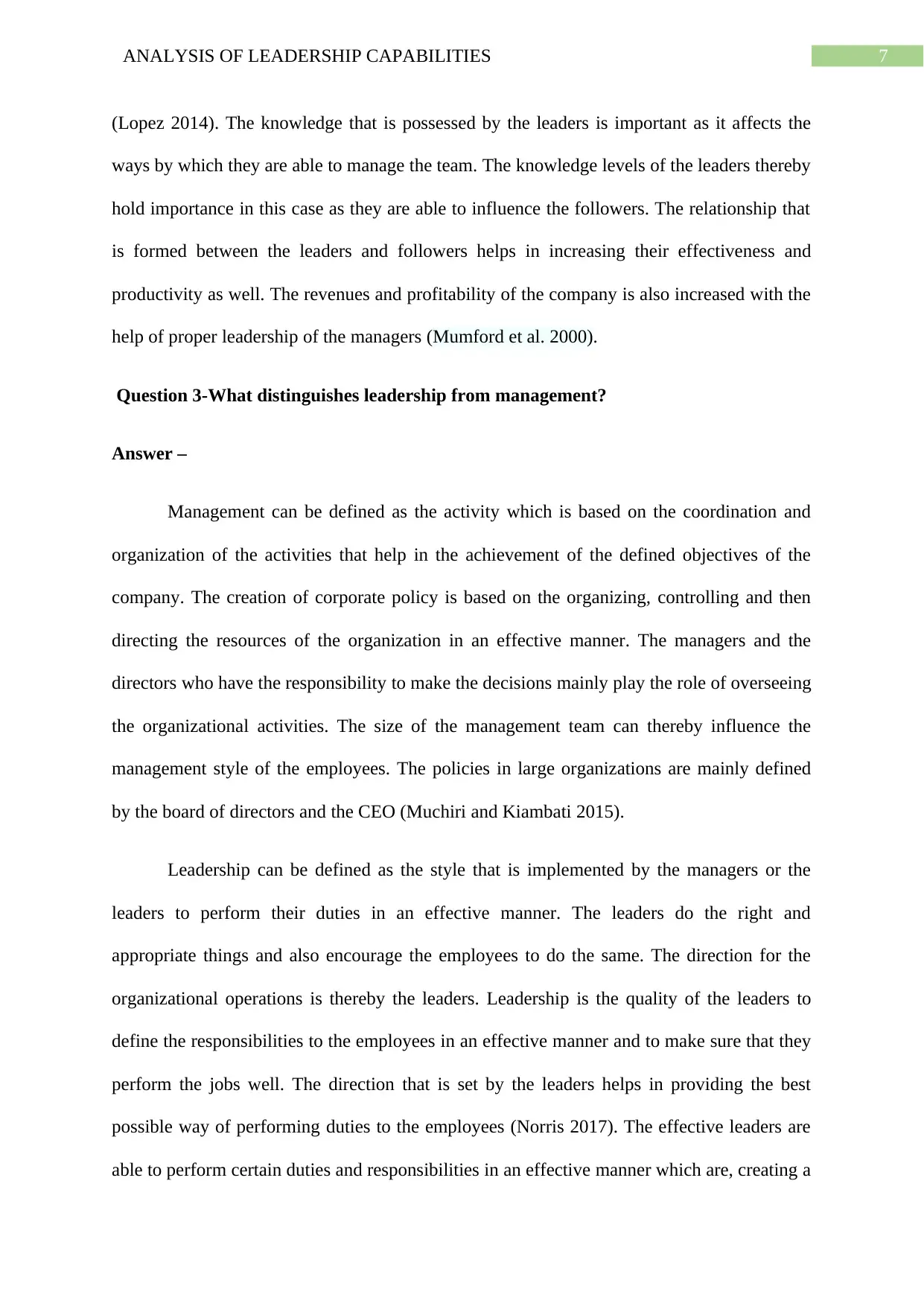
7ANALYSIS OF LEADERSHIP CAPABILITIES
(Lopez 2014). The knowledge that is possessed by the leaders is important as it affects the
ways by which they are able to manage the team. The knowledge levels of the leaders thereby
hold importance in this case as they are able to influence the followers. The relationship that
is formed between the leaders and followers helps in increasing their effectiveness and
productivity as well. The revenues and profitability of the company is also increased with the
help of proper leadership of the managers (Mumford et al. 2000).
Question 3-What distinguishes leadership from management?
Answer –
Management can be defined as the activity which is based on the coordination and
organization of the activities that help in the achievement of the defined objectives of the
company. The creation of corporate policy is based on the organizing, controlling and then
directing the resources of the organization in an effective manner. The managers and the
directors who have the responsibility to make the decisions mainly play the role of overseeing
the organizational activities. The size of the management team can thereby influence the
management style of the employees. The policies in large organizations are mainly defined
by the board of directors and the CEO (Muchiri and Kiambati 2015).
Leadership can be defined as the style that is implemented by the managers or the
leaders to perform their duties in an effective manner. The leaders do the right and
appropriate things and also encourage the employees to do the same. The direction for the
organizational operations is thereby the leaders. Leadership is the quality of the leaders to
define the responsibilities to the employees in an effective manner and to make sure that they
perform the jobs well. The direction that is set by the leaders helps in providing the best
possible way of performing duties to the employees (Norris 2017). The effective leaders are
able to perform certain duties and responsibilities in an effective manner which are, creating a
(Lopez 2014). The knowledge that is possessed by the leaders is important as it affects the
ways by which they are able to manage the team. The knowledge levels of the leaders thereby
hold importance in this case as they are able to influence the followers. The relationship that
is formed between the leaders and followers helps in increasing their effectiveness and
productivity as well. The revenues and profitability of the company is also increased with the
help of proper leadership of the managers (Mumford et al. 2000).
Question 3-What distinguishes leadership from management?
Answer –
Management can be defined as the activity which is based on the coordination and
organization of the activities that help in the achievement of the defined objectives of the
company. The creation of corporate policy is based on the organizing, controlling and then
directing the resources of the organization in an effective manner. The managers and the
directors who have the responsibility to make the decisions mainly play the role of overseeing
the organizational activities. The size of the management team can thereby influence the
management style of the employees. The policies in large organizations are mainly defined
by the board of directors and the CEO (Muchiri and Kiambati 2015).
Leadership can be defined as the style that is implemented by the managers or the
leaders to perform their duties in an effective manner. The leaders do the right and
appropriate things and also encourage the employees to do the same. The direction for the
organizational operations is thereby the leaders. Leadership is the quality of the leaders to
define the responsibilities to the employees in an effective manner and to make sure that they
perform the jobs well. The direction that is set by the leaders helps in providing the best
possible way of performing duties to the employees (Norris 2017). The effective leaders are
able to perform certain duties and responsibilities in an effective manner which are, creating a
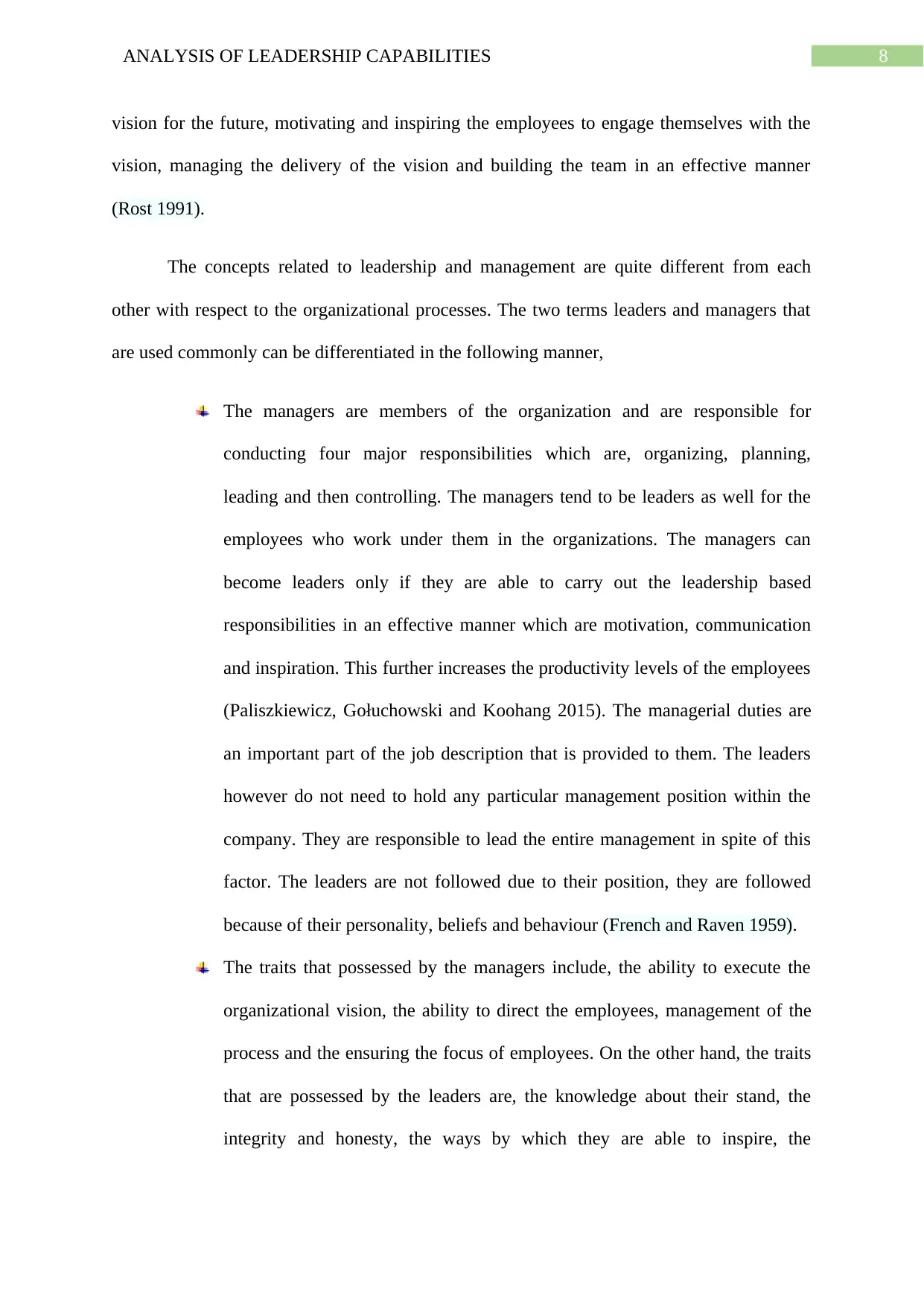
8ANALYSIS OF LEADERSHIP CAPABILITIES
vision for the future, motivating and inspiring the employees to engage themselves with the
vision, managing the delivery of the vision and building the team in an effective manner
(Rost 1991).
The concepts related to leadership and management are quite different from each
other with respect to the organizational processes. The two terms leaders and managers that
are used commonly can be differentiated in the following manner,
The managers are members of the organization and are responsible for
conducting four major responsibilities which are, organizing, planning,
leading and then controlling. The managers tend to be leaders as well for the
employees who work under them in the organizations. The managers can
become leaders only if they are able to carry out the leadership based
responsibilities in an effective manner which are motivation, communication
and inspiration. This further increases the productivity levels of the employees
(Paliszkiewicz, Gołuchowski and Koohang 2015). The managerial duties are
an important part of the job description that is provided to them. The leaders
however do not need to hold any particular management position within the
company. They are responsible to lead the entire management in spite of this
factor. The leaders are not followed due to their position, they are followed
because of their personality, beliefs and behaviour (French and Raven 1959).
The traits that possessed by the managers include, the ability to execute the
organizational vision, the ability to direct the employees, management of the
process and the ensuring the focus of employees. On the other hand, the traits
that are possessed by the leaders are, the knowledge about their stand, the
integrity and honesty, the ways by which they are able to inspire, the
vision for the future, motivating and inspiring the employees to engage themselves with the
vision, managing the delivery of the vision and building the team in an effective manner
(Rost 1991).
The concepts related to leadership and management are quite different from each
other with respect to the organizational processes. The two terms leaders and managers that
are used commonly can be differentiated in the following manner,
The managers are members of the organization and are responsible for
conducting four major responsibilities which are, organizing, planning,
leading and then controlling. The managers tend to be leaders as well for the
employees who work under them in the organizations. The managers can
become leaders only if they are able to carry out the leadership based
responsibilities in an effective manner which are motivation, communication
and inspiration. This further increases the productivity levels of the employees
(Paliszkiewicz, Gołuchowski and Koohang 2015). The managerial duties are
an important part of the job description that is provided to them. The leaders
however do not need to hold any particular management position within the
company. They are responsible to lead the entire management in spite of this
factor. The leaders are not followed due to their position, they are followed
because of their personality, beliefs and behaviour (French and Raven 1959).
The traits that possessed by the managers include, the ability to execute the
organizational vision, the ability to direct the employees, management of the
process and the ensuring the focus of employees. On the other hand, the traits
that are possessed by the leaders are, the knowledge about their stand, the
integrity and honesty, the ways by which they are able to inspire, the
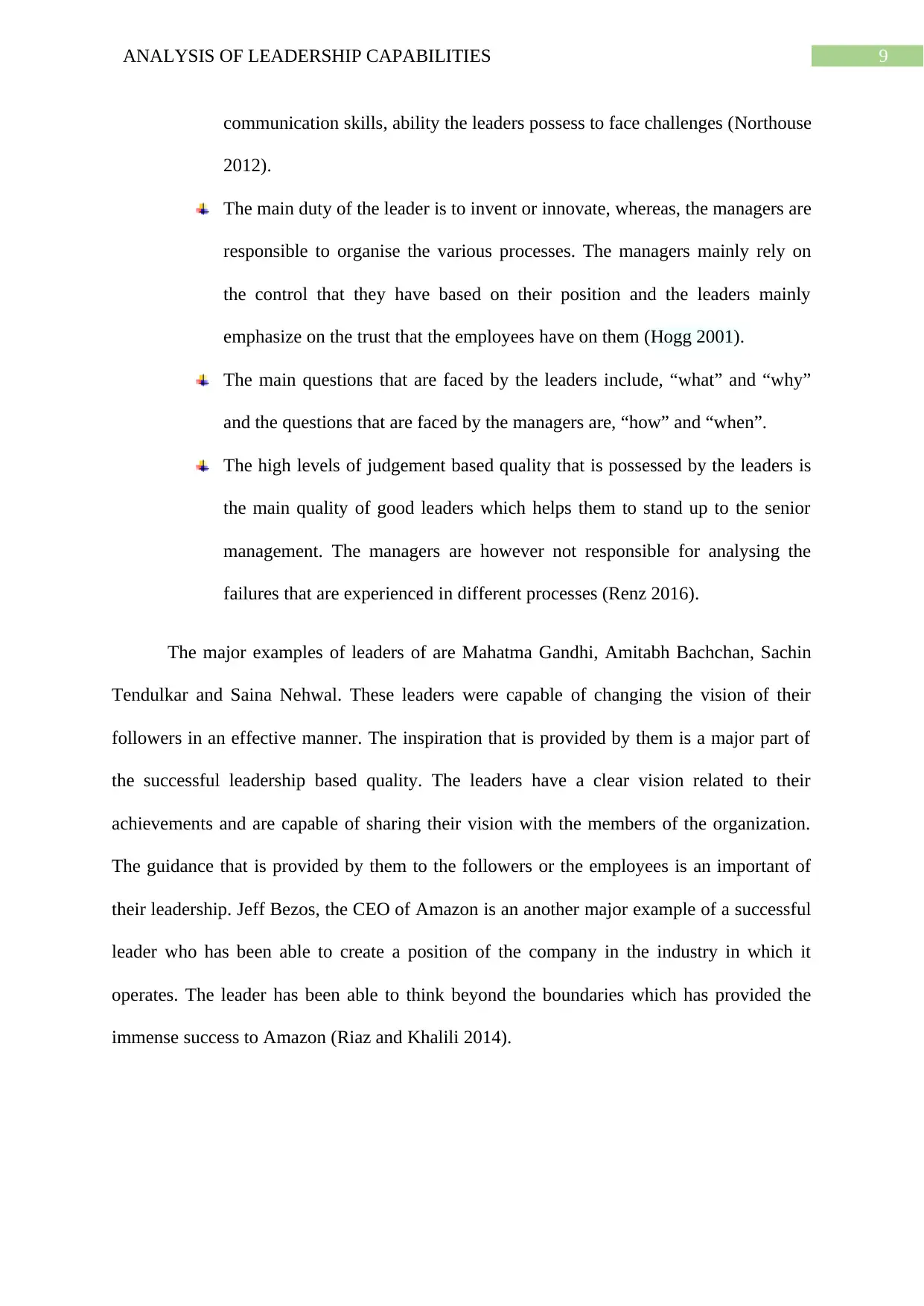
9ANALYSIS OF LEADERSHIP CAPABILITIES
communication skills, ability the leaders possess to face challenges (Northouse
2012).
The main duty of the leader is to invent or innovate, whereas, the managers are
responsible to organise the various processes. The managers mainly rely on
the control that they have based on their position and the leaders mainly
emphasize on the trust that the employees have on them (Hogg 2001).
The main questions that are faced by the leaders include, “what” and “why”
and the questions that are faced by the managers are, “how” and “when”.
The high levels of judgement based quality that is possessed by the leaders is
the main quality of good leaders which helps them to stand up to the senior
management. The managers are however not responsible for analysing the
failures that are experienced in different processes (Renz 2016).
The major examples of leaders of are Mahatma Gandhi, Amitabh Bachchan, Sachin
Tendulkar and Saina Nehwal. These leaders were capable of changing the vision of their
followers in an effective manner. The inspiration that is provided by them is a major part of
the successful leadership based quality. The leaders have a clear vision related to their
achievements and are capable of sharing their vision with the members of the organization.
The guidance that is provided by them to the followers or the employees is an important of
their leadership. Jeff Bezos, the CEO of Amazon is an another major example of a successful
leader who has been able to create a position of the company in the industry in which it
operates. The leader has been able to think beyond the boundaries which has provided the
immense success to Amazon (Riaz and Khalili 2014).
communication skills, ability the leaders possess to face challenges (Northouse
2012).
The main duty of the leader is to invent or innovate, whereas, the managers are
responsible to organise the various processes. The managers mainly rely on
the control that they have based on their position and the leaders mainly
emphasize on the trust that the employees have on them (Hogg 2001).
The main questions that are faced by the leaders include, “what” and “why”
and the questions that are faced by the managers are, “how” and “when”.
The high levels of judgement based quality that is possessed by the leaders is
the main quality of good leaders which helps them to stand up to the senior
management. The managers are however not responsible for analysing the
failures that are experienced in different processes (Renz 2016).
The major examples of leaders of are Mahatma Gandhi, Amitabh Bachchan, Sachin
Tendulkar and Saina Nehwal. These leaders were capable of changing the vision of their
followers in an effective manner. The inspiration that is provided by them is a major part of
the successful leadership based quality. The leaders have a clear vision related to their
achievements and are capable of sharing their vision with the members of the organization.
The guidance that is provided by them to the followers or the employees is an important of
their leadership. Jeff Bezos, the CEO of Amazon is an another major example of a successful
leader who has been able to create a position of the company in the industry in which it
operates. The leader has been able to think beyond the boundaries which has provided the
immense success to Amazon (Riaz and Khalili 2014).
Paraphrase This Document
Need a fresh take? Get an instant paraphrase of this document with our AI Paraphraser
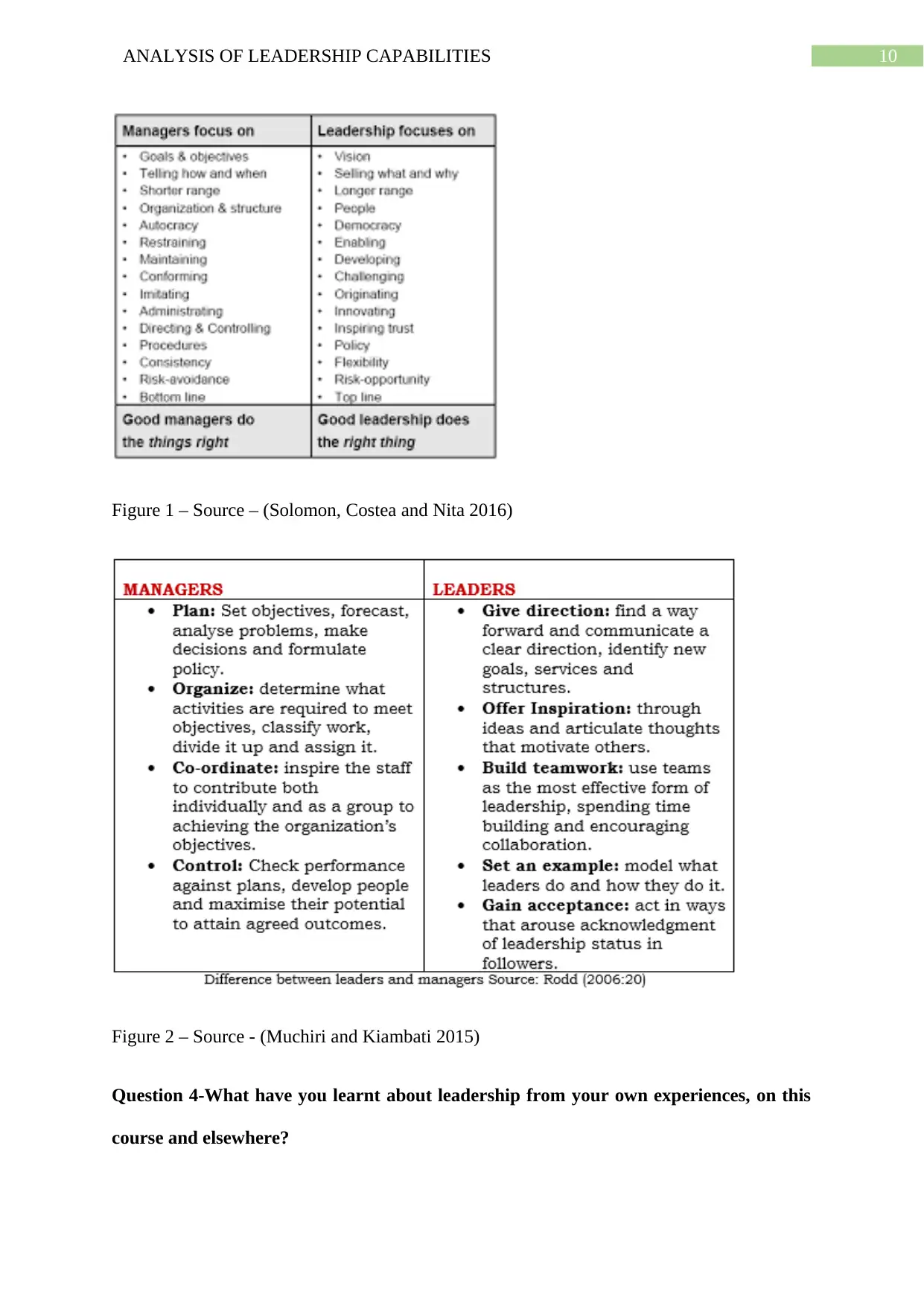
10ANALYSIS OF LEADERSHIP CAPABILITIES
Figure 1 – Source – (Solomon, Costea and Nita 2016)
Figure 2 – Source - (Muchiri and Kiambati 2015)
Question 4-What have you learnt about leadership from your own experiences, on this
course and elsewhere?
Figure 1 – Source – (Solomon, Costea and Nita 2016)
Figure 2 – Source - (Muchiri and Kiambati 2015)
Question 4-What have you learnt about leadership from your own experiences, on this
course and elsewhere?
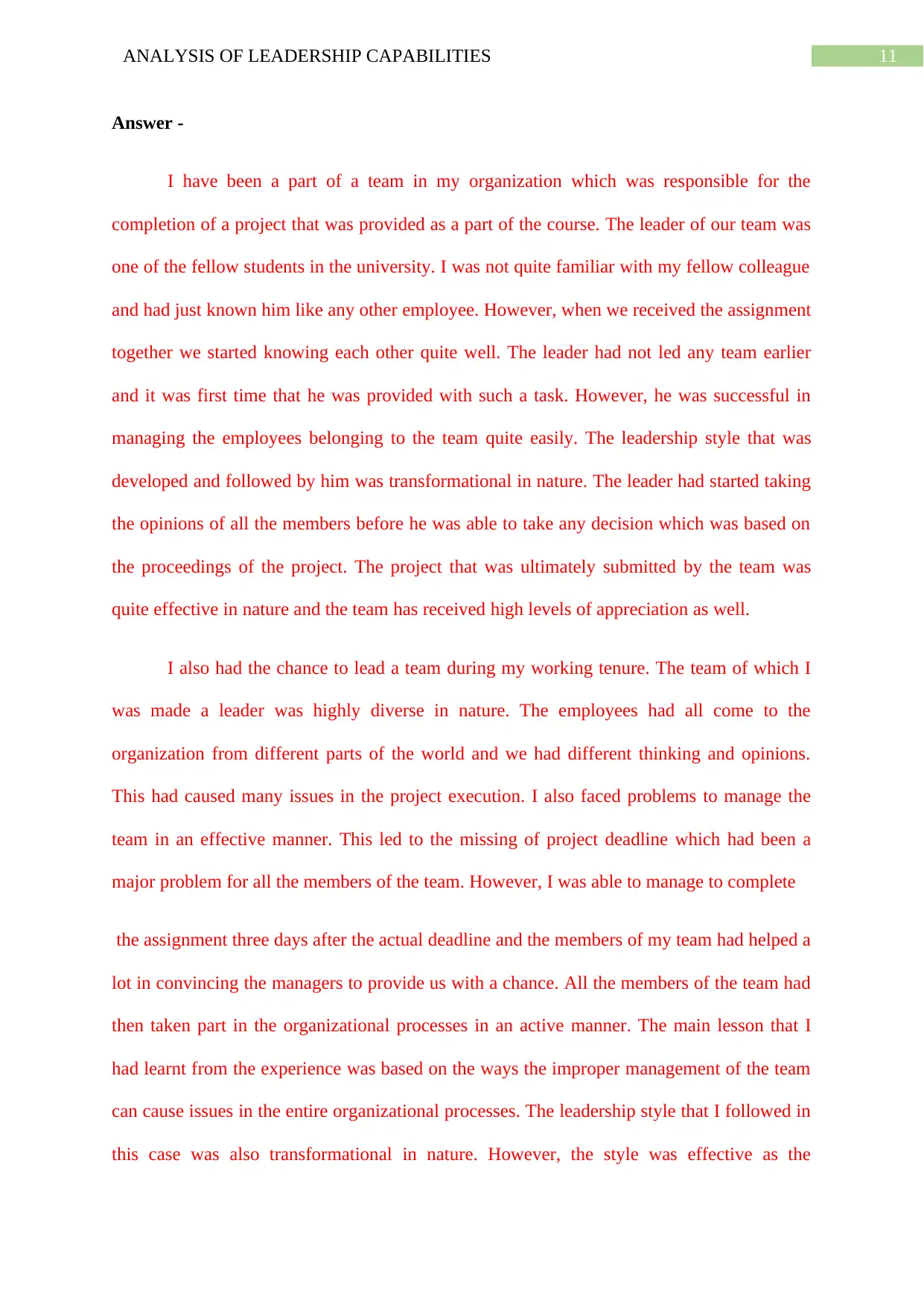
11ANALYSIS OF LEADERSHIP CAPABILITIES
Answer -
I have been a part of a team in my organization which was responsible for the
completion of a project that was provided as a part of the course. The leader of our team was
one of the fellow students in the university. I was not quite familiar with my fellow colleague
and had just known him like any other employee. However, when we received the assignment
together we started knowing each other quite well. The leader had not led any team earlier
and it was first time that he was provided with such a task. However, he was successful in
managing the employees belonging to the team quite easily. The leadership style that was
developed and followed by him was transformational in nature. The leader had started taking
the opinions of all the members before he was able to take any decision which was based on
the proceedings of the project. The project that was ultimately submitted by the team was
quite effective in nature and the team has received high levels of appreciation as well.
I also had the chance to lead a team during my working tenure. The team of which I
was made a leader was highly diverse in nature. The employees had all come to the
organization from different parts of the world and we had different thinking and opinions.
This had caused many issues in the project execution. I also faced problems to manage the
team in an effective manner. This led to the missing of project deadline which had been a
major problem for all the members of the team. However, I was able to manage to complete
the assignment three days after the actual deadline and the members of my team had helped a
lot in convincing the managers to provide us with a chance. All the members of the team had
then taken part in the organizational processes in an active manner. The main lesson that I
had learnt from the experience was based on the ways the improper management of the team
can cause issues in the entire organizational processes. The leadership style that I followed in
this case was also transformational in nature. However, the style was effective as the
Answer -
I have been a part of a team in my organization which was responsible for the
completion of a project that was provided as a part of the course. The leader of our team was
one of the fellow students in the university. I was not quite familiar with my fellow colleague
and had just known him like any other employee. However, when we received the assignment
together we started knowing each other quite well. The leader had not led any team earlier
and it was first time that he was provided with such a task. However, he was successful in
managing the employees belonging to the team quite easily. The leadership style that was
developed and followed by him was transformational in nature. The leader had started taking
the opinions of all the members before he was able to take any decision which was based on
the proceedings of the project. The project that was ultimately submitted by the team was
quite effective in nature and the team has received high levels of appreciation as well.
I also had the chance to lead a team during my working tenure. The team of which I
was made a leader was highly diverse in nature. The employees had all come to the
organization from different parts of the world and we had different thinking and opinions.
This had caused many issues in the project execution. I also faced problems to manage the
team in an effective manner. This led to the missing of project deadline which had been a
major problem for all the members of the team. However, I was able to manage to complete
the assignment three days after the actual deadline and the members of my team had helped a
lot in convincing the managers to provide us with a chance. All the members of the team had
then taken part in the organizational processes in an active manner. The main lesson that I
had learnt from the experience was based on the ways the improper management of the team
can cause issues in the entire organizational processes. The leadership style that I followed in
this case was also transformational in nature. However, the style was effective as the

12ANALYSIS OF LEADERSHIP CAPABILITIES
members provided different opinions and no specific conclusion could be reached in this
case. This has also taught me a lesson that all styles of leadership are not effective in all the
situations.
members provided different opinions and no specific conclusion could be reached in this
case. This has also taught me a lesson that all styles of leadership are not effective in all the
situations.
Secure Best Marks with AI Grader
Need help grading? Try our AI Grader for instant feedback on your assignments.

13ANALYSIS OF LEADERSHIP CAPABILITIES
References
Amanchukwu, R.N., Stanley, G.J. and Ololube, N.P., 2015. A review of leadership theories,
principles and styles and their relevance to educational management. Management, 5(1),
pp.6-14.
Balon, R., 2014. Leadership versus management. Academic Psychiatry, 38(6), pp.720-722.
Bolden, R., 2016. Leadership, management and organisational development. In Gower
handbook of leadership and management development (pp. 143-158). Routledge.
Cox, J.A., 2016. Leadership and Management Roles: Challenges and Success
Strategies. AORN journal, 104(2), pp.154-160.
de Barros, F.B., Goedegebuure, L., Meek, V.L. and Pettigrew, A., 2015. Institutional
governance, leadership and management of research for innovation and development. In The
Palgrave International Handbook of Higher Education Policy and Governance (pp. 261-
280). Palgrave Macmillan, London.
Donate, M.J. and de Pablo, J.D.S., 2015. The role of knowledge-oriented leadership in
knowledge management practices and innovation. Journal of Business Research, 68(2),
pp.360-370.
Edwards, G., Schedlitzki, D., Turnbull, S. and Gill, R., 2015. Exploring power assumptions
in the leadership and management debate. Leadership & Organization Development
Journal, 36(3), pp.328-343.
French, J.R. and Raven, B. (1959) ‘The bases of social power’, in D.Cartwright (ed) Studies
in Social Power (pp. 259-269), Ann Arbor, MI: Institute for Social Research
References
Amanchukwu, R.N., Stanley, G.J. and Ololube, N.P., 2015. A review of leadership theories,
principles and styles and their relevance to educational management. Management, 5(1),
pp.6-14.
Balon, R., 2014. Leadership versus management. Academic Psychiatry, 38(6), pp.720-722.
Bolden, R., 2016. Leadership, management and organisational development. In Gower
handbook of leadership and management development (pp. 143-158). Routledge.
Cox, J.A., 2016. Leadership and Management Roles: Challenges and Success
Strategies. AORN journal, 104(2), pp.154-160.
de Barros, F.B., Goedegebuure, L., Meek, V.L. and Pettigrew, A., 2015. Institutional
governance, leadership and management of research for innovation and development. In The
Palgrave International Handbook of Higher Education Policy and Governance (pp. 261-
280). Palgrave Macmillan, London.
Donate, M.J. and de Pablo, J.D.S., 2015. The role of knowledge-oriented leadership in
knowledge management practices and innovation. Journal of Business Research, 68(2),
pp.360-370.
Edwards, G., Schedlitzki, D., Turnbull, S. and Gill, R., 2015. Exploring power assumptions
in the leadership and management debate. Leadership & Organization Development
Journal, 36(3), pp.328-343.
French, J.R. and Raven, B. (1959) ‘The bases of social power’, in D.Cartwright (ed) Studies
in Social Power (pp. 259-269), Ann Arbor, MI: Institute for Social Research
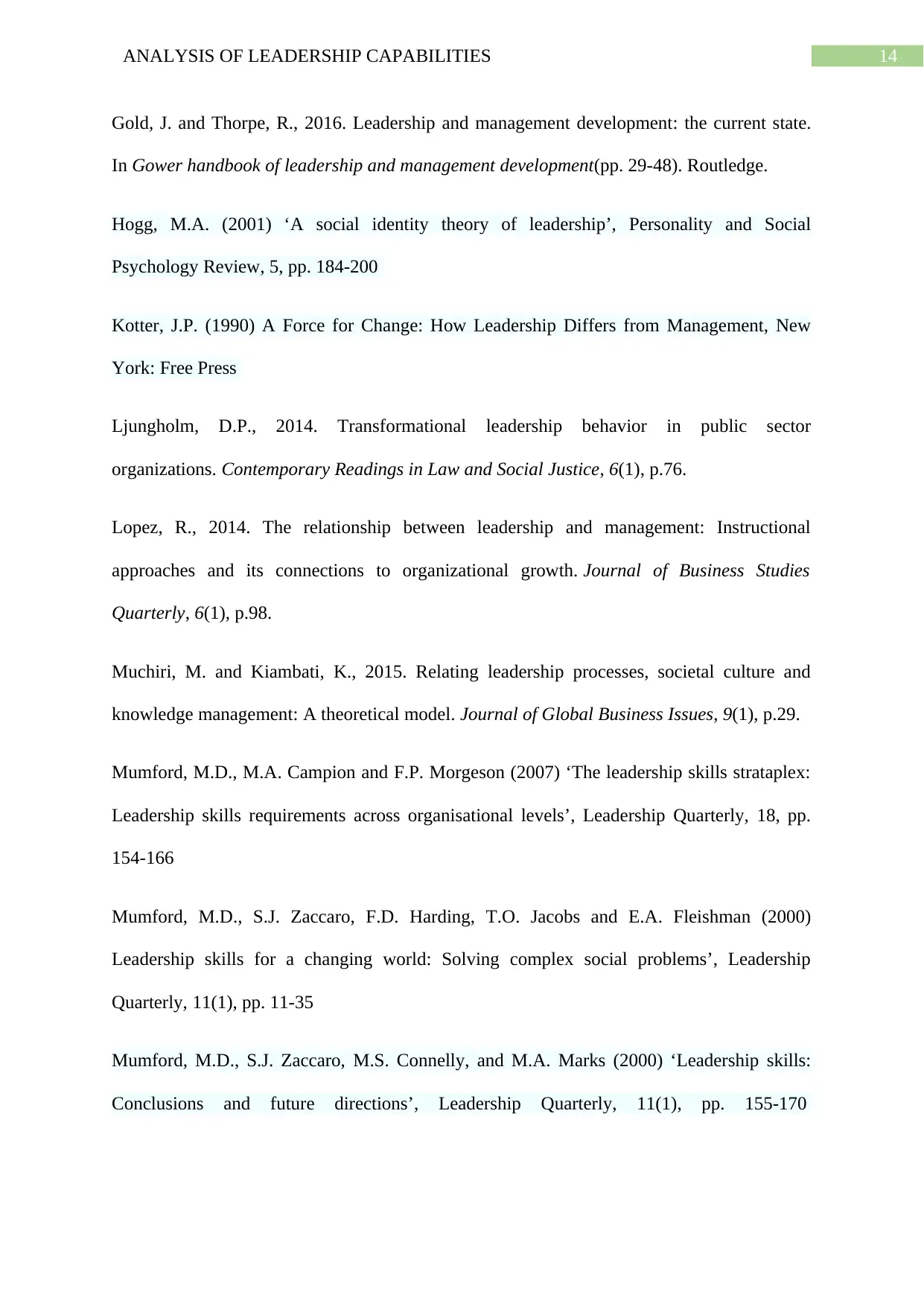
14ANALYSIS OF LEADERSHIP CAPABILITIES
Gold, J. and Thorpe, R., 2016. Leadership and management development: the current state.
In Gower handbook of leadership and management development(pp. 29-48). Routledge.
Hogg, M.A. (2001) ‘A social identity theory of leadership’, Personality and Social
Psychology Review, 5, pp. 184-200
Kotter, J.P. (1990) A Force for Change: How Leadership Differs from Management, New
York: Free Press
Ljungholm, D.P., 2014. Transformational leadership behavior in public sector
organizations. Contemporary Readings in Law and Social Justice, 6(1), p.76.
Lopez, R., 2014. The relationship between leadership and management: Instructional
approaches and its connections to organizational growth. Journal of Business Studies
Quarterly, 6(1), p.98.
Muchiri, M. and Kiambati, K., 2015. Relating leadership processes, societal culture and
knowledge management: A theoretical model. Journal of Global Business Issues, 9(1), p.29.
Mumford, M.D., M.A. Campion and F.P. Morgeson (2007) ‘The leadership skills strataplex:
Leadership skills requirements across organisational levels’, Leadership Quarterly, 18, pp.
154-166
Mumford, M.D., S.J. Zaccaro, F.D. Harding, T.O. Jacobs and E.A. Fleishman (2000)
Leadership skills for a changing world: Solving complex social problems’, Leadership
Quarterly, 11(1), pp. 11-35
Mumford, M.D., S.J. Zaccaro, M.S. Connelly, and M.A. Marks (2000) ‘Leadership skills:
Conclusions and future directions’, Leadership Quarterly, 11(1), pp. 155-170
Gold, J. and Thorpe, R., 2016. Leadership and management development: the current state.
In Gower handbook of leadership and management development(pp. 29-48). Routledge.
Hogg, M.A. (2001) ‘A social identity theory of leadership’, Personality and Social
Psychology Review, 5, pp. 184-200
Kotter, J.P. (1990) A Force for Change: How Leadership Differs from Management, New
York: Free Press
Ljungholm, D.P., 2014. Transformational leadership behavior in public sector
organizations. Contemporary Readings in Law and Social Justice, 6(1), p.76.
Lopez, R., 2014. The relationship between leadership and management: Instructional
approaches and its connections to organizational growth. Journal of Business Studies
Quarterly, 6(1), p.98.
Muchiri, M. and Kiambati, K., 2015. Relating leadership processes, societal culture and
knowledge management: A theoretical model. Journal of Global Business Issues, 9(1), p.29.
Mumford, M.D., M.A. Campion and F.P. Morgeson (2007) ‘The leadership skills strataplex:
Leadership skills requirements across organisational levels’, Leadership Quarterly, 18, pp.
154-166
Mumford, M.D., S.J. Zaccaro, F.D. Harding, T.O. Jacobs and E.A. Fleishman (2000)
Leadership skills for a changing world: Solving complex social problems’, Leadership
Quarterly, 11(1), pp. 11-35
Mumford, M.D., S.J. Zaccaro, M.S. Connelly, and M.A. Marks (2000) ‘Leadership skills:
Conclusions and future directions’, Leadership Quarterly, 11(1), pp. 155-170
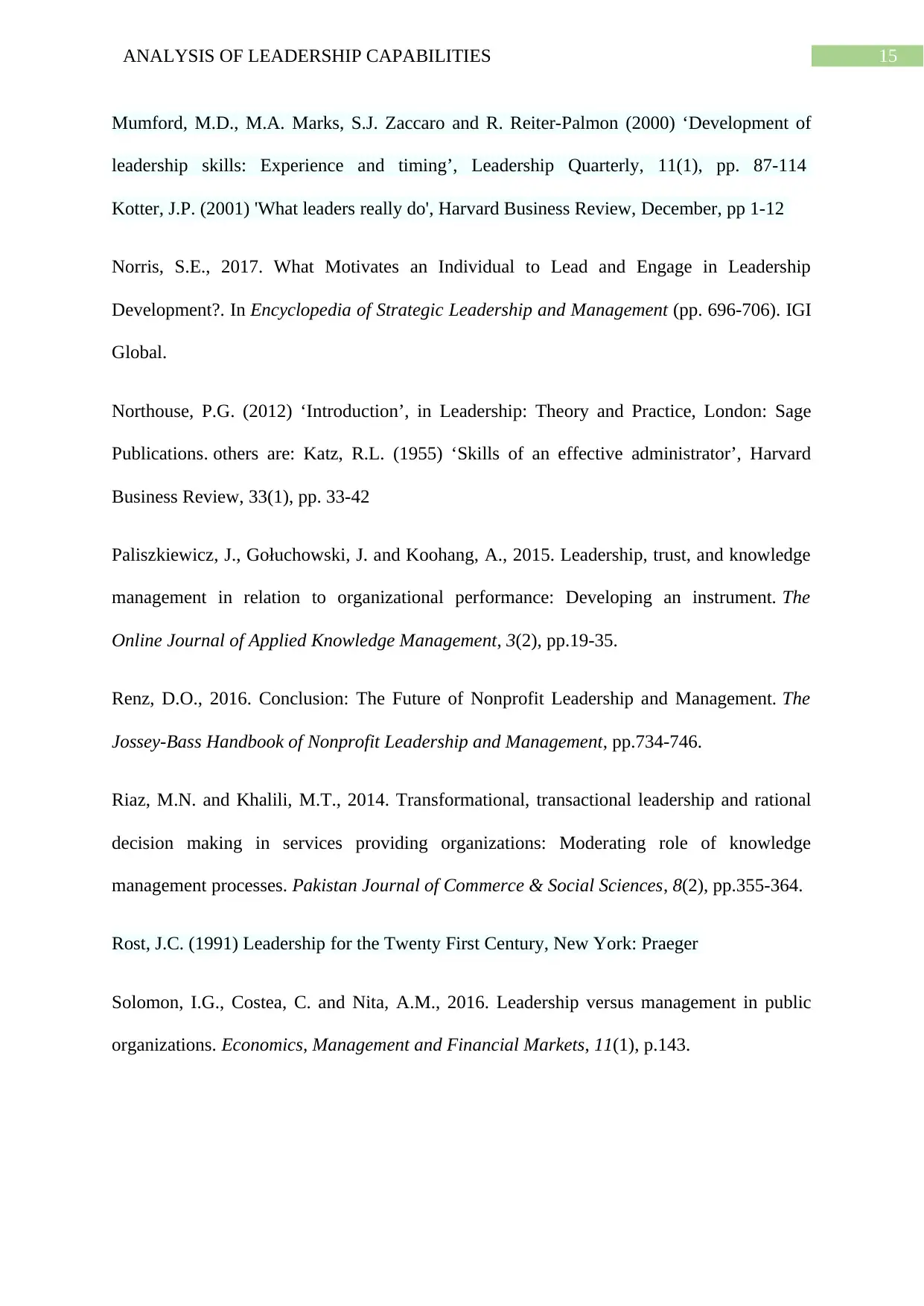
15ANALYSIS OF LEADERSHIP CAPABILITIES
Mumford, M.D., M.A. Marks, S.J. Zaccaro and R. Reiter-Palmon (2000) ‘Development of
leadership skills: Experience and timing’, Leadership Quarterly, 11(1), pp. 87-114
Kotter, J.P. (2001) 'What leaders really do', Harvard Business Review, December, pp 1-12
Norris, S.E., 2017. What Motivates an Individual to Lead and Engage in Leadership
Development?. In Encyclopedia of Strategic Leadership and Management (pp. 696-706). IGI
Global.
Northouse, P.G. (2012) ‘Introduction’, in Leadership: Theory and Practice, London: Sage
Publications. others are: Katz, R.L. (1955) ‘Skills of an effective administrator’, Harvard
Business Review, 33(1), pp. 33-42
Paliszkiewicz, J., Gołuchowski, J. and Koohang, A., 2015. Leadership, trust, and knowledge
management in relation to organizational performance: Developing an instrument. The
Online Journal of Applied Knowledge Management, 3(2), pp.19-35.
Renz, D.O., 2016. Conclusion: The Future of Nonprofit Leadership and Management. The
Jossey‐Bass Handbook of Nonprofit Leadership and Management, pp.734-746.
Riaz, M.N. and Khalili, M.T., 2014. Transformational, transactional leadership and rational
decision making in services providing organizations: Moderating role of knowledge
management processes. Pakistan Journal of Commerce & Social Sciences, 8(2), pp.355-364.
Rost, J.C. (1991) Leadership for the Twenty First Century, New York: Praeger
Solomon, I.G., Costea, C. and Nita, A.M., 2016. Leadership versus management in public
organizations. Economics, Management and Financial Markets, 11(1), p.143.
Mumford, M.D., M.A. Marks, S.J. Zaccaro and R. Reiter-Palmon (2000) ‘Development of
leadership skills: Experience and timing’, Leadership Quarterly, 11(1), pp. 87-114
Kotter, J.P. (2001) 'What leaders really do', Harvard Business Review, December, pp 1-12
Norris, S.E., 2017. What Motivates an Individual to Lead and Engage in Leadership
Development?. In Encyclopedia of Strategic Leadership and Management (pp. 696-706). IGI
Global.
Northouse, P.G. (2012) ‘Introduction’, in Leadership: Theory and Practice, London: Sage
Publications. others are: Katz, R.L. (1955) ‘Skills of an effective administrator’, Harvard
Business Review, 33(1), pp. 33-42
Paliszkiewicz, J., Gołuchowski, J. and Koohang, A., 2015. Leadership, trust, and knowledge
management in relation to organizational performance: Developing an instrument. The
Online Journal of Applied Knowledge Management, 3(2), pp.19-35.
Renz, D.O., 2016. Conclusion: The Future of Nonprofit Leadership and Management. The
Jossey‐Bass Handbook of Nonprofit Leadership and Management, pp.734-746.
Riaz, M.N. and Khalili, M.T., 2014. Transformational, transactional leadership and rational
decision making in services providing organizations: Moderating role of knowledge
management processes. Pakistan Journal of Commerce & Social Sciences, 8(2), pp.355-364.
Rost, J.C. (1991) Leadership for the Twenty First Century, New York: Praeger
Solomon, I.G., Costea, C. and Nita, A.M., 2016. Leadership versus management in public
organizations. Economics, Management and Financial Markets, 11(1), p.143.
Paraphrase This Document
Need a fresh take? Get an instant paraphrase of this document with our AI Paraphraser

16ANALYSIS OF LEADERSHIP CAPABILITIES
1 out of 17
Related Documents
Your All-in-One AI-Powered Toolkit for Academic Success.
+13062052269
info@desklib.com
Available 24*7 on WhatsApp / Email
![[object Object]](/_next/static/media/star-bottom.7253800d.svg)
Unlock your academic potential
© 2024 | Zucol Services PVT LTD | All rights reserved.





